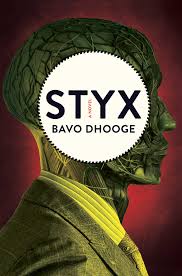Styx: A Novel
- By Bavo Dhooge with Josh Pachter
- Simon451
- 292 pp.
- Reviewed by Terry Zobeck
- November 24, 2015
A zombie teams up with a detective to solve gruesome murders.

Chief Inspector Raphael Styx of the Ostend (Belgium) police department is having a bad day. He is a corrupt cop shunned by his colleagues, saddled with a painful arthritic hip, trapped in an increasingly loveless marriage, and despised by his acne-covered teenage son. As bad as all this is, it’s about to get a lot worse. He’s about to become a zombie.
Styx is working the “Stuffer” serial killer case, so nicknamed by the media because of the killer’s habit of eviscerating his victims and stuffing them with sand. He then arranges the bodies in public places in poses reminiscent of those used by famous Belgian surrealist painters of the Belle Époque.
As the novel Styx opens, the character Styx is investigating the gruesome murder of the Stuffer’s third victim, the dismembered and headless torso of a young woman in a macabre display on Ostend’s beach. Styx’s only lead is a phone call from the citizen who called in the discovery, leaving only his last name, Spilliaert. Styx tracks him to an apartment in Ostend but Spilliaert is not there. In the course of pursuing him, Styx is shot and killed.
Usually the death of the lead character so early in a detective novel would be a major plot problem, but not for Styx. A short while after being killed Styx wakes up, and while covered in blood and clearly remembering dying, he still manages to rise up and walk away from the cabana before the Stuffer can return to arrange his next grisly tableau.
Soon Styx begins to note that he’s a tad stinky and doesn’t seem to have a pulse. When his flesh begins to rot the penny drops and he realizes he is a zombie. Albeit a zombie with a keen desire to track down the person who killed him and the detective skills with which to do it. He also has the aid of an antique watch that when opened takes him back a hundred years to Belle Époque Belgium and provides the inspiration to solve one aspect of the case.
With his bloodshot and deep sunk yellow eyes, sallow complexion, and putrefying flesh Styx realizes he can’t conduct his investigation in the open. Besides, with the Stuffer posting the death photograph on his Facebook page everyone thinks Styx is dead.
With Styx’s death, the Stuffer case is turned over to Joachim Delacroix, a young homicide detective of Congolese descent whose career was on the rise as Styx’s was on the decline. Styx dislikes and resents the handsome and fashionably dressed Delacroix, but is forced into an uneasy alliance with him.
Understandably, Delacroix has a bit of difficulty in accepting that Styx is a zombie. Despite their many differences, including that one is alive and the other undead, Delacroix helps Styx to work the case and remain undetected.
In the hope of drawing out the Stuffer they hold a fake funeral for Styx. In his will, Styx asked to be buried at sea to the tune of Styx’s “Come Sail Away” — his mother was a fan — but instead his widow, Isabelle, selects Van Morrison’s “Into the Mystic.” The ploy doesn’t work, but at least Isabelle got the music right.
One might expect that this strange mash-up of detective-zombie-time-travel genres would be a chaotic mess. No attempt is made to explain Styx’s transformation into a zombie. There is little real detection involved — Styx solves the case via a large dollop of coincidence. The book doesn’t dwell on the horrific aspects of zombie lore — Styx only satisfies his slow-to-recognize zombie hunger once. The time-travel aspect, while evocative, is unexplained and of little relevance to the plot other than to provide Styx with insight as to why the Stuffer poses his victims as he does.
Through a balance of dark humor, noir style, and avoidance of over-the-top slapstick, Dhooge and Pachter make it all work. The most successful aspects of the novel are Styx’s realization of what he has lost and can never regain — the love of his wife and son — and his troubled relationship with Delacroix.
Terry Zobeck is a substance-abuse researcher with the federal government. In his off hours, he is an avid book and music collector.

